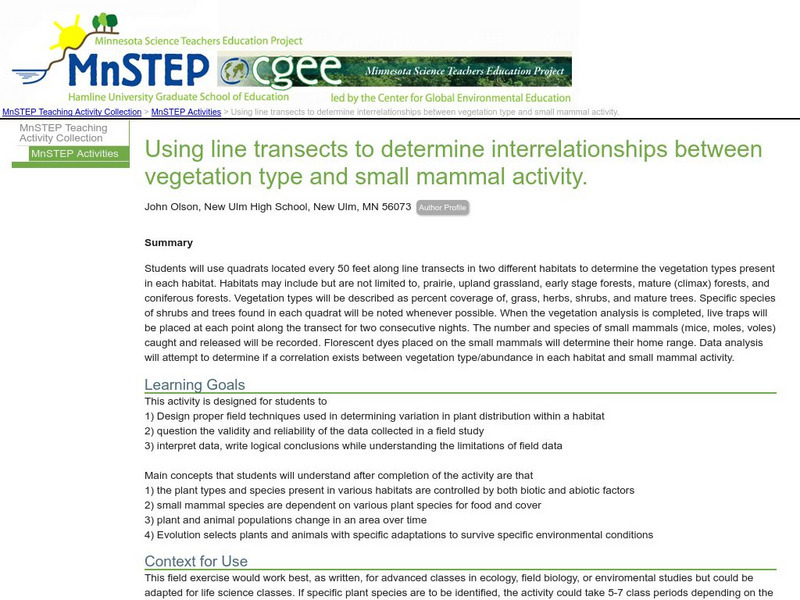Hi, what do you want to do?
Curated OER
Who Works in This Forest?
Students examine the variety of jobs that are related to working in the forest. Information on the different jobs is provided in this lesson plan for the teacher to share with the students. The students create a collage using magazines...
Curated OER
Gale's Curriculum
Seventh graders develop an understanding of Southeastern Asian culture. They increase knowledge of world geography in relation to Southeast Asian countries. Students research a variety of Southeast Asian animals and habitats to be used...
Curated OER
The Energy Debate - Conclusion
High schoolers write a persuasive essay about the choices in the energy debate. They comprehend the environmental consequences that accompany the decision. Students predict how they will power their future.
Curated OER
Sarita Wetland Restoration
Students collaborate on the plannng and implementation of the Sarita Wetland Restoration. The Sarita Wetland is the remnant of former Lake Sarita that was drained in the early 1900's. The goal of the entire project is to improve water...
Curated OER
SHOW 303: The Channel Island Fox
Students explore how archaeologists and other scientists use different clues to piece together a picture of the past. Students perform activities that allow them to conduct three types of scientific research. They discuss their...
Curated OER
School Forest Lesson- Looking at Literature
Students compare what they learned though literature to the school forest. In this environment lesson plan, students visit the forest surrounding their school to listen to literature and identify objects in nature. Students create...
Curated OER
Exploring Marine Objects
Students identify the sources of water on Earth. In this life science lesson, students list the different plants and animals that live in the ocean. They explore marine objects in the lab and draw them.
Curated OER
Exploring Life in the Coral Reef
Learners study life forms in coral reefs. In this ocean life lesson plan, students study life in coral reefs as they create a coral reef sculpture.
Science Education Resource Center at Carleton College
Serc: Using Plant Surveys to Study Biodiversity
An extended field investigation intended as launch into several concepts in environmental science including biodiversity, human impacts on natural systems, and energy transfer in ecosystems.
Alabama Learning Exchange
Alex: What Kind of Plant Is It?
This lesson provides a fun way for students to learn to classify plants as vascular and nonvascular. Students will use drawing software to create pictures of vascular and nonvascular plants.
Alabama Learning Exchange
Alex: The Circles of Life
This is an inquiry based cooperative learning unit that can be used in biology as a graduation exam review or in botany for a nine week project. The learners will learn the life cycle of mosses, ferns, gymnosperms and angiosperms. The...
Huntington Library
Huntington Library: Garden Lesson Plans: Seeing Seeds [Pdf]
An exploration for younger students into the diversity of seeds and what is inside a seed. Includes extension activities.
Science Education Resource Center at Carleton College
Serc: Determining Interrelationships: Vegetation Type and Small Mammal Activity
Learners design proper field techniques to determine variation in plant distribution within a habitat, and then interpret data, write logical conclusions, while understanding the limitations of field data.
Yale University
Yale New Haven Teachers Institute: Evolution of Plants
An extensive coverage of the evolutionary history of plants. Click on a topic in the outline and you'll go to a good discussion on this material.
Huntington Library
Huntington Library: Learning From Leaves: From Observation to Inference [Pdf]
A lesson plan in which learners explore plants from three different ecosystems and make inferences about plant structures and their environments. Includes discussion questions, a vocabulary glossary, and handouts.
Utah STEM Foundation
Utah Stem Action Center: Backyard Organisms
Utah is a beautiful state with a rich and diverse population of living creatures. This activity challenges you to spend a few minutes outside thinking about and observing the organisms living in your backyard.
Science Education Resource Center at Carleton College
Serc: Investigating Simple Plants
Learners will gather moss from the schoolyard, and observe it carefully, documenting their observations in their science notebooks. They will develop an investigable question from their observations, design and run an investigation on...
Climate Literacy
Clean: Temperature and Precipitation as Limiting Factors in Ecosystems
Students correlate graphs of vegetation vigor with those of temperature and precipitation data for four diverse ecosystems, ranging from those near the equator to the poles, to determine which climatic factor is limiting growth.
Alabama Learning Exchange
Alex: Invasive Plants
Invasive plants are non-native plants that grow in an environment that has no native diseases, parasites, or predators. This allows them to grow rapidly and be destructive to native plants.
Alabama Learning Exchange
Alex: Gymnosperms, Cone Bearing Vascular Plants
Students will research printed encyclopedias, Internet resources (thinkfinity.org) and their science textbook to gather information to answer questions and draw an assigned portion of the Life Cycle of the Gymnosperms. This lesson plan...
PBS
Pbs Learning Media: Lesson 8: Color Your World
For this lesson, students play a guessing game to explore different fruits and vegetables, emphasizing the diversity of colorful foods available for them to eat. Students prepare and eat a colorful, plant-based salad and brainstorm ways...
Other popular searches
- Plant Diversity Activities
- Plant Diversity Map
- Genetics and Plant Diversity
- Plant Diversity Section 22.2
- Plant Diversity Section 222
- Plant Diversity Worksheet
















![Huntington Library: Garden Lesson Plans: Seeing Seeds [Pdf] Lesson Plan Huntington Library: Garden Lesson Plans: Seeing Seeds [Pdf] Lesson Plan](https://static.lp.lexp.cloud/images/attachment_defaults/resource/large/FPO-knovation.png)





